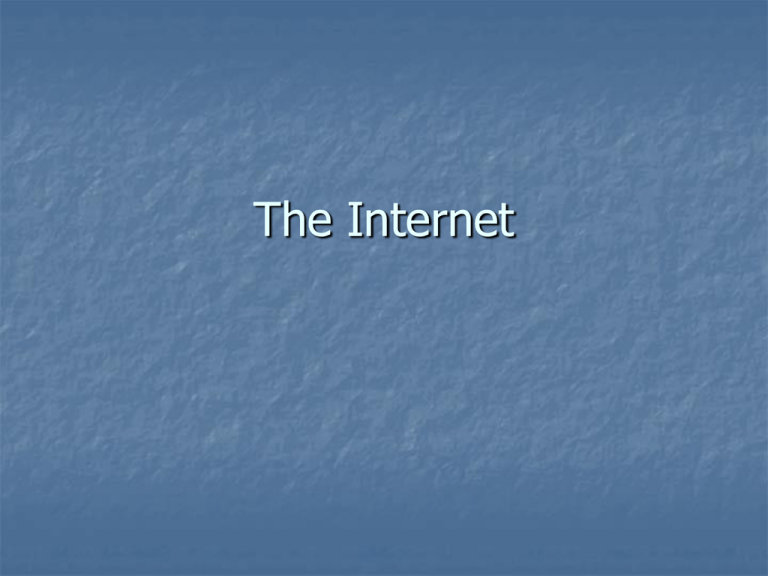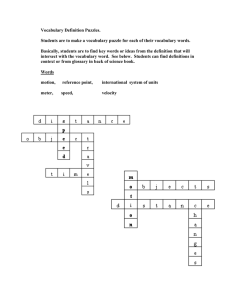The Internet
advertisement

The Internet Internet A network is a group of connected computers that can interact with each other and share resources The internet is a large network that spans the entire Earth. It is actually a network made up of many smaller networks that are all combined. Internet The internet is more than just web pages and the W W W (World Wide Web). The internet includes the www, newsgroups, email and other shared resources. So, the world wide web is a part of the internet. Web Pages and Web Sites A web page is a single file or page on the world wide web that can display images and text, links to other web pages and can be designed to be interactive. A web site is a collection of two or more connected or linked web pages. Browser A browser is a program that allows a user to view web pages on the World Wide Web. The 4 most popular browsers: Internet Explorer Mozilla Firefox Safari Opera Browser Different browsers display web pages in different ways. As a web page designer it is important to design your page with at least Internet Explorer and Firefox in mind – make it work with both browsers! How the Internet Works (Basically) On a network there are two types of machines: A server is a computer that shares files and other resources such as a printer with other computers on a on a network. A client is a computer on a network that accesses files or resources on another computer (server). How the Internet Works (Basically) So, if you are viewing files on your screen that are actually saved on a different computer that makes your machine the client and the machine that you are viewing the files from the server. A computer can be both a client and a server at the same time. How the Internet Works (Basically) So the world wide web is a large network made up of many servers and clients. The servers are storing the web sites, and the clients are viewing those web sites. For example, let’s say ‘www.anything.com’ is saved on a computer in Missoula, MT. You type in ‘www.anything.com’ in your browser here in Watkinsville. The web page that you are seeing is being sent all the way from Missoula where it is stored. How the Internet Works (Basically) So the big question is: When you type in ‘www.anything.com’, how does your browser know to look on a server in Missoula, MT to find it? How the Internet Works (Basically) There are many servers around the world that store web pages for the world wide web. Every computer – whether it’s a server or client is given a unique identification number when it connects to the internet. This unique number is called an I.P. Address How the Internet Works (Basically) An IP Address looks like the following: 192.168.120.101 There are four segments to an IP Address. The numbers that make up each segment can be from 0 – 255 (although the very first segment can’t have a zero). How the Internet Works (Basically) To connect to the internet and receive an IP Address for your computer, you must have an ISP (Internet Service Provider). There are two types of ISP’s: Dial-up Broadband How the Internet Works (Basically) Dial-up ISPs America Online Earthlink Net Zero Broadband ISPs Charter Bell South DSL (basically, cable and DSL connections are the two broadband options) How the Internet Works (Basically) Dial-up internet access requires your computer to dial a phone number to connect and is very slow Broadband internet access is always connected, and has much faster speeds for loading web pages and downloading files How the Internet Works (Basically) Every time that you connect to your ISP, whether by calling in to your dial-up connection or restarting your broadband modem you get a new IP address. This is called a dynamic IP address. If your computer keeps the same IP address always and it never changes it is called a static IP address. How the Internet Works (Basically) Servers that are storing or hosting a website have static IP addresses. This means that if you know the IP address for a server you can always find that webpage. Wouldn’t it be nice if there was a place that stored that information? A place that knew what the IP address was for every server and what web pages were stored there? How the Internet Works (Basically) A DNS Server (Domain Name Service) stores that information. But what if you had to remember an IP address for every single web page that you want to visit? Could you remember them all? Instead of google.com what if you had to remember that it was 64.110.98.24 How the Internet Works (Basically) A domain name is a group of letters that represent the IP address for a particular web site. anything.com is an example of a domain name. cia.gov is a domain name. lost.tv is a domain name. How the Internet Works (Basically) So instead of having to remember IP addresses, you just have to remember the domain name. That’s what a DNS server does – it keeps track of which domain names are associated with which IP address so that when you type in google.com, the DNS server knows that means to actually go to 64.233.167.104 How the Internet Works (Basically) URL (Uniform Resource Locator) is what you type into your browser to request a page. The URL contains the domain name, and additional path information and the protocol. The protocol is the http:// part at the very beginning. How the Internet Works (Basically) http (hypertext transfer protocol) tells the browser that you are requesting a document created using hypertext – what we will be writing our web pages with. Most browsers do not require you to write http:// or even www. before typing in the rest of the address. http://www.google.com should be the same as typing google.com How the Internet Works (Basically) The additional path information is if the webpage you are trying to view is in a subfolder http://www.google.com/folder/inhere/index.htm Notice that for URLs we use / or forward slash. When using the path on our computer it is a back slash or \ C:\programs\microsoft\word.exe http://www.google.com/folder/index.htm How the Internet Works (Basically) So to sum it all up You type in the URL for a website into your browser. Your browser is connected to the internet through your ISP. It checks the ISP’s DNS server to see what IP address matches up with the domain name and where it is located. The request is sent to the server at that IP address and the web page is sent back to your browser. Putting Your Website Online You know how it works, you’ve made a website, now you want to get it published online so others can see it. There are three things you have to do: 1. 2. 3. Register a domain name Find a host Upload your files Register A Domain Name Pick a domain name – yourname.com or whatever you want. You’ll need to check to make sure it hasn’t been taken. You can do that here: www.internic.com/whois.html You can also check to see if it is taken at many other places as well. Register A Domain Name Registering a domain name costs money. Usually around $7.95/year. There are many websites you can visit to register your domain. A quick search in google will provide you with a long list to choose from. Find A Host The host is the company that you pay money to allow you to store your website files on their server. Some hosts also register domain names as well. Some hosts are free, but do not allow you to have your own domain name. Find A Host Again, searching google.com will provide you with a long list of website hosts. The host will provide you with a specific amount of disk space on which to save your files More importantly the host provides your website with an IP address that doesn’t change. After finding a host, your domain is registered on the name servers to point to that IP address. Upload Your Files Dowloading is when you copy or move files from another computer to your own computer. Uploading is when you copy or move files from your computer to another computer. Now that you have a domain name and a server to host your website, you have to upload your website files to the server. Upload Your Files Uploading your files to the server is done by using an FTP (File Transfer Protocol) program. There are many free FTP programs available – just search google! Putting Your Website Online Once you’ve uploaded your files, your website is ready to go. It may take a day or two for your website to show up after registering the domain name and setting up your host. Hosting A Website On Your Own Computer Bad Idea You have to pay extra to have a static IP address, meaning an IP address that never changes. Most ISPs provide you with a dynamic IP address – meaning it changes every time you connect. It opens your computer up to major security concerns It will cause your connection to the internet to slow to a crawl as more and more people visit your site. Your page will load slowly for people who visit your site Many ISPs have contracts that specifically state that you may not host your own website using the IP address they assign you. Important Terms network Internet W W W (World Wide Web) Web page Web site Browser URL (Uniform Resource Locator) Server Client IP Address ISP (Internet Service Provider) Hosting DNS (Domain Name Service) Domain Name http (hypertext transfer protocol) Downloading Uploading




